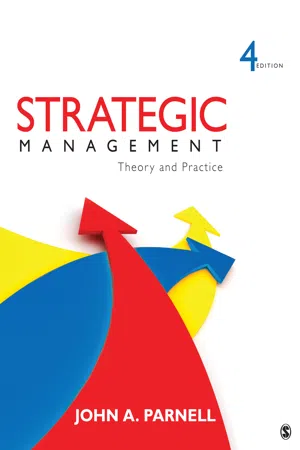Business
External Factors Affecting Business
External factors affecting business refer to the outside influences that can impact a company's operations and performance. These factors can include economic conditions, political stability, technological advancements, social trends, and environmental regulations. Businesses must monitor and adapt to these external factors to remain competitive and sustainable in their respective industries.
Written by Perlego with AI-assistance
Related key terms
1 of 5
10 Key excerpts on "External Factors Affecting Business"
- eBook - ePub
Strategic Analytics
Integrating Management Science and Strategy
- Martin Kunc(Author)
- 2018(Publication Date)
- Wiley(Publisher)
3 External Environment: Political, Economic, Societal, Technological and Environmental FactorsObjectives
- To define exogenous factors
- To learn tools for foreseeing changes in exogenous factors
- To organize external environment information for decision making
Learning outcomes and managerial capabilities developed
- To develop sensemaking managerial capabilities
- To classify the impact of external factors into threats and opportunities
Strategic choices are a function of conditions of the internal and external factors and the possibility of influencing them. The external environment, or external factors, can affect the organization's choices as well as its performance so it is fundamental to consider them within the strategic management process even though it will be impossible to affect them. The closeness of the external factors to the organization implies the possibility for the organization to influence, within a certain time horizon, conditions of these factors. The external environment can be divided into three parts according to the closeness to the organization: rivalry with existing organizations; industry dynamics defined by the suppliers, potential entrants, substitutes and customers; and the general or remote environment defined by the political, economic, social, technological and environmental factors (Figure 3.1 ).External factors affecting the organization.Figure 3.1External factors can not only be threats to the survival of the organization but also opportunities to achieve the vision defined for the organization or even redefine it. Therefore, organizations may need to design strategies to defend themselves against a threat or follow opportunities arising from favorable changes in the external factors. This chapter addresses the factors residing in the general or remote environment.Political
These factors examine the political situation since government regulations and legal issues play a role in its economy and can ultimately affect the organization. Examples of such factors are tax policies, environmental policy, labor laws, international trade barriers and tariffs. It is essential for organizations to asses and align themselves with these policies in order to devise strategies which will enable them to operate successfully in the market and, thus, avoid government pressures as an interested stakeholder. Government policies can become a huge impediment to the growth of an organization if they affect strategic choices in terms of business models. Government policies may also become highly beneficial if they are supporting the growth of the industry or creating barriers to avoid competition. - Robert J. Chapman(Author)
- 2011(Publication Date)
- Wiley(Publisher)
Part IV External Influences – Macro FactorsBusinesses clearly do not operate in a vacuum but in an ever-changing scenario where changes in the operating environment are beyond the control of any individual business. This part of the book examines the way in which external “macro” influences impact businesses. These macro factors are distinct from micro factors inasmuch as they are events that occur at both national and international level. Micro factors influence individual businesses or consumers in the domestic market. An understanding of how these external macro influences impact on a business is important as it provides an appreciation of how a business is subject to constraints and exposed to opportunities. Macro factors include the state of the economy, the environment, the legal framework, political structure, market conditions and social factors. These subjects are discussed in the following chapters and describe the sources of risk included in the risk taxonomy included in Chapter 9 (see Table 9.1 ). The sequence of the chapters follows the sequence in which the subjects appear in the taxonomy, as shown in Figure P4.1 . An extract of the taxonomy is given in Table P4.1 for ease of reference and assimilation.Figure P4.1 Structure of Part IVTable P4.1 Business operating environmentPassage contains an image 21 Economic Risk Everything that can be counted does not necessarily count; everything that counts cannot necessarily be counted. (Albert Einstein)
This chapter examines economic risk , the first of the six macro influences within the section of the risk taxonomy called “business operating environment” described in Chapter 11. Businesses do not operate in a vacuum. Hence, it would be difficult to comprehend an enterprise risk management process that did not address economic risk. The subject of economics relates to the allocation of resources. Economic business risk emanates from the performance of the national economy within which a business operates and the way its government elects to influence the economy and solve the basic economic problem of scarce resources and competing needs. Economics has such a large influence on business performance that managers must take steps to understand and predict economic phenomena and respond accordingly. While the subject is vast and it is only possible to examine some of the rudimentary elements of the body of economic theory here, any review of enterprise risk management that did not address those aspects of economics regularly encountered by businesses would clearly be incomplete. The structure of this chapter is illustrated in Figure 21.1- Jennifer Raga(Author)
- 2020(Publication Date)
- Society Publishing(Publisher)
Factors like population growth, career inclinations, distribution of age and health consciousness are all considered when setting up a business. Technological factors – Technology is a profound part of every business and it’s always changing. Technology not only affects marketing but also production methods and tendencies, distribution and communication within the management of the business. Factors Influencing Growth Of Small And Medium... 53 Environmental factors – Pollution restrictions (like carbon emission targets) and availability of raw materials are some of the environmental factors that can affect the growth and operations of a business. After all, consumers are preferring to buy products and services are responsibly sourced. Legal factors – With regards to legal factors, there’s plenty the business has to consider. This includes, but not limited to the health and safety regulations, employee rights, consumer laws and rights, production standards and product safety among others. 3.2 ENVIRONMENTAL FACTORS A healthy business environment is critical particularly in the case of the tourism and hospitality niche. Environment, in this case, is an ambiguous term that refers to various facets all of which are crucial to the existence of business in the tourism and hospitality industry. The various facets covered under the umbrella term ‘Environment’ are: • Economic environment • Legal environment • Political environment • Social environment • Physical environment 3.2.1 Economic Environment The economic environment dictates the purchasing power of the consumers and their spending patterns. Some of the factors that determine the state of the economic environment are; • Economic policies – Economic policies determine the economic culture in the country. Such policies can also influence spending tendencies among the citizenry. Some policies like lower interest rates can bolster lending improving spending power among consumers.- eBook - ePub
Technological Capability and Learning in Firms
Vietnamese Industries in Transition
- Tran Ngoc Ca(Author)
- 2019(Publication Date)
- Taylor & Francis(Publisher)
8 External factors and learning activities External factors are divided into four main groups: macro-economic policies of the government: financial and taxation policies; monetary, banking and investment policies; policy of labour and management; and trade policy. market factors : both domestic and international. supporting infrastructure : R&D, education and training; activities of other organisations which have a bearing on factors such as information, documentation, consultancy, standardisation, quality control, industrial property rights, etc. other social and cultural factors. These four groups of factors will be the main influential categories to exercise impact on the business and learning efforts of firms. At the same time, the transition from a planning to a market economy system is the most significant feature of Vietnam, which in turn, has decisive influences on all four groups of factors. Therefore, these influences will be examined more closely, in terms of both positive and to a larger extent, negative aspect. 8.1 Influences of external factors on firms' business activities The ranking of influences of external factors on firms' business activities is given in Table 8.1 : most of the firms indicated that macroeconomic policies and the supporting system were the most influential factors. In the interviews, firms’ managers tended to argue more about the problems they faced rather than overall influences, whether positive or negative - eBook - PDF
- Ellen Auster, K. Wylie, Michael Valente(Authors)
- 2005(Publication Date)
- Palgrave Macmillan(Publisher)
However, this regulatory change might be beneficial to Fresh, since a key differentiator of their product is its use of organic fruits. If an organization is considering expanding to new geographic markets, either domestically or internationally, a careful analysis of political factors can be particularly important. A thoughtful political analysis will reveal both the new political opportunities and obstacles that crossing borders can involve. Some examples of political factors we may want to continuously monitor when assessing the external context include: • tax policies • employment laws • environmental regulations • trade restrictions and tariffs • political stability • intellectual property protection • favored trading partners • anti-trust laws • pricing regulations • health and safety regulations. Economic Economic forces have far-reaching consequences for our organizations. For example, a recessionary period can severely limit the purchasing power of potential customers while a drop in interest rates might prompt a factory upgrade. In the case of Fresh, a strong dollar might restrict exports to other countries. As with political factors, our assessment should include the current economic conditions as well as a projection of future trends and their impact. Some specific economic factors we may want to continuously monitor when assessing the external context include: • economic growth • interest rates • exchange rates • inflation rates • unemployment levels • discretionary income • infrastructure quality • workforce skill levels • labor costs • business cycles. Social Social forces such as demographic and cultural factors can influence everything from the age distribution of the population, to consumer opinion, to the values that are driving market demand. - eBook - PDF
- Paul Sweeting(Author)
- 2011(Publication Date)
- Cambridge University Press(Publisher)
5 The external environment 5.1 Introduction The external risk management environment refers to everything that can affect the risks faced by an institution and the way those risks are managed. These factors are not uniform, and vary by industry and geographical location. Even within a particular industry in a particular country, different types of firms might find themselves in different environments. Small firms might be treated differently from large ones, and privately held ones will certainly be treated differently from publicly quoted ones. The list of potential firm-specific factors is extensive – but the important point here is that it is not sufficient simply to look at the industry and location and decide that all firms will be treated the same; rather, it is important every time to consider the nature of the firm and how this affects the external context. 5.2 External stakeholders Since it was established in the previous chapter that the number of internal stakeholders was small, it follows that the number of external stakeholders that might exist is large. All principals except the owner-managers are exter- nal to the institutions. This means that the other holders of bank and insurance company debt and equity are external, as are pension scheme sponsors; all customers, policyholders, pensioners and other beneficiaries are external; and clearly the government, the markets and any statutory insurance arrangements are external. By contrast, the agents are generally the insiders. This is particularly true for banks and insurance companies, where only trade unions and external auditors can be considered external; however, for pension schemes, foundations and endowments, where more facilities are likely to be outsourced, then functions 61 62 The external environment such as investment management and benefit administration are also frequently external. - eBook - PDF
- Paul Sweeting(Author)
- 2017(Publication Date)
- Cambridge University Press(Publisher)
5 The External Environment 5.1 Introduction The external risk management environment refers to everything that can affect the risks faced by an institution and the way those risks are managed. These factors are not uniform, and vary by industry and geographical location. Even within a partic- ular industry in a particular country, different types of firms might find themselves in different environments. Small firms might be treated differently from large ones, and privately held ones will certainly be treated differently from publicly quoted ones. The list of potential firm-specific factors is extensive – but the important point here is that it is not sufficient simply to look at the industry and location and decide that all firms will be treated the same; rather, it is important every time to consider the nature of the firm and how this affects the external context. 5.2 External Stakeholders Since it was established in the previous chapter that the number of internal stake- holders was small, it follows that the number of external stakeholders that might exist is large. All principals except the owner-managers are external to the institu- tions. This means that the other holders of bank and insurance company debt and equity are external, as are pension scheme sponsors; all customers, policyholders, pensioners and other beneficiaries are external; and clearly the government, the markets and any statutory insurance arrangements are external. By contrast, the agents are generally the insiders. This is particularly true for banks and insurance companies, where only trade unions and external auditors can be considered external; however, for pension schemes, foundations and endow- ments, where more facilities are likely to be outsourced, then functions such as investment management and benefit administration are also frequently external. Professional and industry bodies and regulators are also external to the organi- - eBook - ePub
Strategic Management
Theory and Practice
- John A. Parnell(Author)
- 2013(Publication Date)
- SAGE Publications, Inc(Publisher)
entire industry. Specifics concerning how these factors affect a particular organization should be elaborated in the section on opportunities and threats, which is later in the analysis.Researching political-legal forces, as well as other environmental forces, requires some digging and intuition and a lot of reading. Rarely will one find a website that provides a comprehensive “macroenvironmental report” for a given firm or industry. When one is conducting research, it is often helpful to create four charts—one for each element in the macroenvironment—and add to it throughout the research process. One may locate direct and indirect references at the company home page and in various articles, but trade journals are often the best single source of information for reports on relevant issues in the external environment. As many as two dozen (or more) different sources may be required to complete the analysis of the four macroenvironmental forces. It is rare that complete and thorough information can be found in only one or two sources.If a company competes in multiple industries (with multiple business units), one needs to analyze the major business units and industries. What constitutes “major” depends on the firm. For example, Ford Motor Company receives the majority of its revenues from automobile sales, but it also has a business unit that provides customer financing. With Ford, it would make the most sense to analyze its automobile business unit and not spend considerable time on the financial business unit. With other companies, however, determining which business unit or units are “major” may be more difficult. The key is to consider the relative contribution of each business unit to corporate revenues and profits. If questions remain, it is a good idea to present the professor with a list of the company’s business units and each one’s proportion of company revenues and profits, along with a proposal on how to proceed, and ask for guidance. - eBook - PDF
Business Practice NQF3 SB
TVET FIRST
- A Suresh, M Ronaldson, A Berman, TL Krul(Authors)
- 2013(Publication Date)
- Macmillan(Publisher)
(www.treasury.gov.za , 2007) It would follow that a large business has over 200 employees and more than R50 million in income. Note : Businesses may fall under more than one of the above-mentioned types of business. For example, Supplyline mentioned previously, is both a Close Corporation and a small business. Unit 17.2 The business environment The business environment refers to all those factors that may have an affect on the business. This includes issues within the business as well as outside of the business. The business environment is made up of the microenvironment, market environment and macroenvironment. The macro- environment The market environment The micro- environment (the business) The microenvironment has limited influence on the market but no influence on the macroenvironment The macroenvironment has an influence on both the market and the microenvironments The business environment Adapted from Bates et al (2006: 13) Which other types of business do the organisations mentioned earlier in this unit fall into? Think about it Which other types of business do the organisations mentioned earlier in this unit fall into? Think about it 137 Module 17: The structures and roles of different types of organisations The microenvironment The microenvironment considers all factors inside of the business. Decisions made by management affect the microenvironment. Included here are the goals of the business, the functions of the organisation, factors of production and management tasks and the strategy of the organisation. Let us look at some aspects of the microenvironment in more detail. • The goals of an organisation may be to make a profit, to aid in charitable causes, etc. • The functions of an organisation will be explained later in this unit. • Production factors are those resources that a business needs to create goods and services that it will sell to customers. - eBook - PDF
Comprehensive Strategic Management
A Guide for Students, Insight for Managers
- Eric J. Bolland(Author)
- 2017(Publication Date)
- Emerald Publishing Limited(Publisher)
1. Will your operations be helped or hurt by a change in leadership in federal, state, or local government? 2. What would be the effects of a change in regulatory requirements for you? 3. What are the tax implications of a change in government? 4. What are major court decisions that could affect your organization? 5. What possible new state and federal laws that might affect your organization? Sources for answers can come from your legislators and lobby groups. The second factor is Economic. There is a mouthful in this term. Here, we are restricting it mostly to macroeconomic factors, not microeconomic theory. The fundamentals of supply, demand, and price have been well established and agreed upon by economists. In this more narrowed de fi nition, economics is the aggregated effect of national economic production, consump-tion, income, savings, and investment. These are big picture areas, not single household or single individual level activities. It can be said the economic health of the United States is manifested in the macroeconomic measures as well as the economic activity of the country as a whole. An indicator of health such as the Gross Domestic Product (GDP) is familiar to most. It measures the productive output of national goods and services. A healthy GDP is one that is show-ing an increase and an unhealthy one shows no growth or decline. What is the connection between this measure and the impact of the economic factor on the organization? A growing economy means a growth in opportunity for organizations. Investment capital is available. Interest rates are lower. There is more consumer spending. If the GDP is down for multiple peri-ods, these advantages and opportunities are not present. 102 COMPREHENSIVE STRATEGIC MANAGEMENT What are some key measures in economics that are applica-ble in the external analysis? 1. GDP, 2. Consumer interest rates, and 3. Consumer con fi dence measures.
Index pages curate the most relevant extracts from our library of academic textbooks. They’ve been created using an in-house natural language model (NLM), each adding context and meaning to key research topics.









